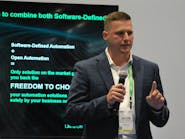What is the future of automation in the water and wastewater sector? That was the primary question at hand during an educational session hosted by Schneider Electric’s Jacob Thompson and AVEVA’s Graeme Fukuda at WEFTEC 2025 in Chicago this week.
Thompson, the company’s business development leader for next generation automation systems, kicked off things by outlining what Schneider Electric’s views are related to the future of automation, along with what the company is seeing in the market. Thompson said Schneider Electric believes in three strong pillars in terms of automation:
- Simplicity and flexibility
- Interoperable and portable
- Autonomous operations
“So, simplicity and flexibility – we don’t need automation systems to be difficult to manage. Whenever we have intercommunication issues, when we have multiple different SCADA systems, when we have multi-vendor automation systems, not a lot of them can speak to each other, and therefore we see that as a growing need to change and have a unified automation structure,” Thompson said.
“Interoperability and portability expand off that first pillar, Thompson continued. “So, if you have a control system that can’t be readily upgraded from one supplier’s hardware to another’s, that can completely change in today’s world.”
“And then autonomous operations. We see it all the time in water and wastewater — the workforce is changing, and there’s also a workforce demand that is pretty high. How do we attract that young workforce? We see that there is a growing trend to make data-driven decisions with less humans doing the work.
Schneider’s open and interoperable approach
The Schneider Electric solution? An open, software-defined automation system called EcoStruxure Automation Expert.
Per Schneider Electric: At its core, EcoStruxure Automation Expert decouples software from hardware, allowing true portability of applications across vendors. It establishes an open platform where best-of-breed solutions can be seamlessly plugged together to build custom automation architectures tailored to unique needs — just like apps on a smartphone.
EcoStruxure Automation Expert makes this vision a reality with a software-defined architecture that simplifies integration and IT/OT convergence. Backed by the UniversalAutomation.org shared source model, it enables truly portable industrial apps that run across any vendor's hardware.
“What Schneider is saying, is that we’re going to make a virtualized, software-defined platform for PLCs but make it completely open — meaning with the software Schneider has, I can control other vendors’ systems, and break away from the vendor-locked systems that you have today,” Thompson said. “In a nutshell, EcoStruxure Automation Expert is one software platform where you can design and build your application, create a simulation … you can create a digital twin of your control network and simulate everything in your process prior to deploying that application on a PLC.”
A contextualization platform, from field to cloud
Thompson then turned things over to Fukuda to discuss CONNECT, which is AVEVA’s open and neutral industrial intelligence platform that is integrated with EcoStruxure Automation Expert and pairs aggregated, contextualized data with predictive analytics to optimize water operations.
The goal of CONNECT, Fukuda said, is data accessibility—and getting the right data to the right people.
“It’s about making that data accessible but then also having a digital throughline throughout this entire industrial lifecycle so that you’re realizing the most value out of that information,” Fukuda said. “So, what we have built is our industrial intelligence platform as a service, CONNECT. We kind of see this as our ecosystem of different apps that can span across this entire industrial lifecycle.
“The world is changing from when our data use cases were within the four walls of a plant,” Fukuda continued. “But now more data generators are out on the edge. Now we’re doing more data sharing with our vendors, with our partners, with the rest of our data ecosystem. We really see this entire architecture as hybrid. You need something that can not only go across this industrial lifecycle, but can also cover edge, the plant, the cloud, to use the right tools for the right use cases.”
Fukuda said the main use cases that AVEVA is targeting are currently split between efficient water use or efficient energy use, but that the company is exploring more use cases and apps to add to the CONNECT platform.
“We can update that quite quickly, push new applications and let partners develop on that same ecosystem where all this data can live,” Fukuda said.
CONNECT enabling AI applications
Additionally, AVEVEA is bringing about an AI assistant as part of its CONNECT platform to help users interact with the information in a manner comparable to ChatGPT.
“We’ve got some certain guardrails around it, so I wouldn’t call it exactly (ChatGPT), but we want people to interact with their data in a conversational style,” Fukuda said. “We want to make sure that this bot can summarize and provide concise content in terms of answers. And we always need to make sure those answers are traceable,” Fukuda said.
Fukuda added that the AI assistant will also have a generative side that can create visualizations such as charts and dashboard to quickly deliver contextual information to users. Session attendees were able to see video demonstrations of CONNECT’s AI capabilities before Fukuda concluded his portion of the presentation.
Thompson then closed things out by sharing his view of the future of automation.
“To sum it up, what does the future of automation look like?” Thompson asked. “It’s open, it’s software-defined and, on top of that, you have access to all the data, and you can take that data one step forward and actually make it actionable data with AVEVA CONNECT.”
